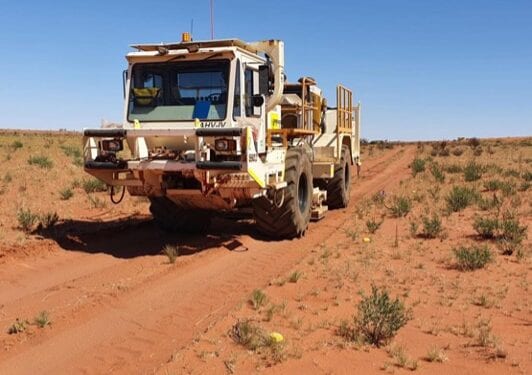Final Seismic Identifies Large Thrust Zone At HN9
Magnetic Resources (ASX:MAU) has identified eight persistent thrusts which have significantly extended the HN9 and Lady Julie mineralised areas near Laverton in Western Australia.
The HN9 and Lady Julie gold projects are located only 15km NW of the Granny Smith Operations owned by Gold Fields Australia Pty Ltd and only 10km NE of the Jupiter Operations owned by Dacian Gold Ltd.
The thrusts, identified through seismic, come close to surface and are at least 6km in length and extend the HN9 and Lady Julie mineralised areas and structures northwards into the HN5 and HN6 areas.
A number of these thrusts are already mineralised, and others are being drill tested in some cases for the first time. An extensive deeper drill programme of 22 holes for 3280m (averaging 150m) is designed to test these large prospective thrust targets and has already started.
Thrust 5 is a linking thrust that correlates with the HN9 3km long mineralisation that is now interpreted to extend onto the NS seismic section at least 1.5km to the NE. This thrust has a surface area of 4 sq km and is a high priority target and deeper drilling is planned here.
The HN9 thickened mineralised zone is also interpreted to extend towards the NS seismic section and is shown up by the intersection of flat dipping thrust 5 and shallow south dipping thrust 4 and is an area of seismic complexity. This zone and its 2km southern shallow south dipping extension is a high priority. Another similar prospective thickened target is present at the intersection of thrust 5 and thrust 3.
Final combined results from the processing of a 2D shallow seismic on an 8km long EW line, an 8km NS line, an EW reprocessed AGSO line and a 30 sq.km passive seismic survey centred on HN9 and extending eastwards to Lady Julie and northwards towards HN5 and HN6, completed in December by Hiseis Pty Ltd.
The seismic surveys were designed for a better understanding of the regional geology, structures and architecture, evaluate down dip extensions of the mineralised lodes, identify repeats of mineralized lodes at depth and along strike and assist in further targeting of new structures. Numerous high priority targets have been identified as described below.
The NS 2D seismic interpretation shows distinct near surface thrusts 3 and 4. Thrust 5 is a linking horizontal thrust and its structure mirrors the 3km long HN9 mineralised wireframe, which has been projected onto this NS section.
The thickened zone projection may be related to the intersection of thrust 4 and 5 and coincides with areas of structural complexity and is a high priority target. This mineralisation may continue southwards along thrust 4 at depth. Both the thickened zone and its deeper 2km continuation represent worthwhile deeper drill targets and are currently being assessed. A second potential thickened target is the intersection of thrust 5 and thrust 3.
The EW 8km 2D seismic line has 10 thrusts over a 5km length. The western thrusts (1 to 5) are associated with the HN9 area. Thrust 4 correlates with the HN9 mineralisation. Thrusts 2 to 5 are being tested as part of the deeper drilling plan. Thrusts 6-10 are associated with the Lady Julie area. Thrust 7 and 8 are associated with known mineralised areas and deeper drilling is planned here, Also, vertical faults between thrusts 7 and 8 are being tested as possible conduits for deeper mineralisation intruding into ultramafic areas adjacent to truncated and multiple thrusted BIFS.
The AGSO NY1 line was reprocessed, and three thrusts were located cutting through the HN5 and HN6 areas. Some of these areas are mineralised at HN5 and deeper downdip drilling is being carried out here. The thrust targets at HN6 are at intersections of NS and NNW directions shown up by the seismic interpretation and by previous ground magnetic surveys. A circular Wallaby look alike magnetic target is now being assessed for deeper drilling at this intersection.
The aim of these surveys is to focus on imaging the deep-seated structure of both HN9, Lady Julie, HN5 and HN6 areas and tie it in with the regional architecture that hosts the Wallaby and Granny Smith Deposits. The lines have been selected and positioned to optimally image the sub-surface structure geology and structure based on the current data.
The data quality of the 2D seismic survey was very good. During the acquisition of the two 2D seismic lines additional nodes were laid out on a regular 250x250m grid pattern to acquire passive seismic data over an area centred on HN9. This passive array is being utilised to show a 3D effect and help with future deeper drill hole location. Hiseis Pty Ltd carried out this seismic survey for Magnetic Resources, utilising the Inova AHV-1V 62,000lb seismic vibrator truck with Inova Quantum nodes, which were laid every 5m along the track. Table 2 shows some of the parameters for this survey.
Managing Director, George Sakalidis, said that with the Australian gold price at near record levels of A$2,297, the HN9 and Lady Julie Projectss are shaping up and have potential for a shallow large-scale mining centre.
“The final seismic results have generated some outstanding targets including eight shallow easterly dipping thrusts that are 6km in length, a 4 sq km thrust interpreted to be associated with the 3km long HN9 mineralisation, a new southerly dipping extension of the thickened mineralisation, another potential thickened zone and a fold trap site with potential vertical fluids.
“These targets and others associated with mineralisation are already starting to be drill tested with an initial extensive 22 hole for 3280m drill programme.”












